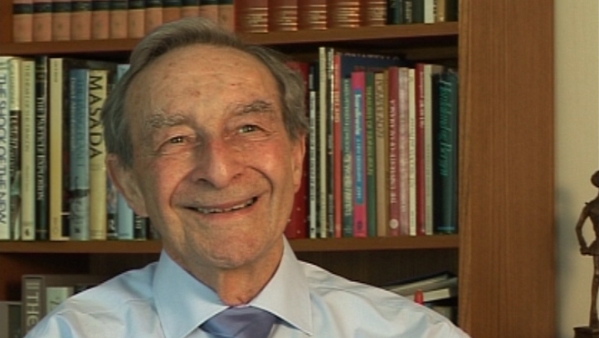NEXT STORY

The Oklo Phenomenon
RELATED STORIES

NEXT STORY

The Oklo Phenomenon
RELATED STORIES


|
Views | Duration | |
|---|---|---|---|
| 101. My graduate students: Peter Perkins and Ian Worrell | 87 | 02:18 | |
| 102. Expansion of the Department of Chemistry at Nottingham University | 73 | 03:44 | |
| 103. My role in IUPAC | 46 | 02:22 | |
| 104. Establishing atomic weights | 50 | 03:35 | |
| 105. Forming a team at IUPAC | 39 | 01:22 | |
| 106. How isotopes affect atomic weight | 51 | 01:27 | |
| 107. Geochemistry determining atomic weight | 45 | 02:14 | |
| 108. How radioactivity affects atomic weight | 46 | 04:36 | |
| 109. The Oklo Phenomenon | 96 | 05:28 | |
| 110. The Oklo sake vase made for me | 54 | 01:10 |


I said that there were several reasons why the atomic weight would vary. One was the geochemistry would alter. A second one is radioactivity. One of the strange things about the periodic table was that the sequence of atoms didn't always exactly follow the atomic weight. Iodine and tellurium are inverted and I think potassium and calcium [sic – should be argon], and the reason is, with the potassium and calcium [sic] that part of the potassium that we have, as you probably know, is radioactive. When people get upset about radioactivity – they don't realise that they are, in fact, surrounded, particularly if they're living in Cornwall, with quite a lot of radioactivity, but it is not at that very low level harmful in any serious way.
But because the atom is mutating from one element to another, the atomic weight of both of them is changing slowly. And that is most noticeable, I suppose, in lead, because lead is the end product of many of the radioactive series, the naturally radioactive series that were discovered by Becquerel and then Curies and so forth at the beginning of the 20th century. Because they alter and all of those series end in lead, depending on the ore that the lead is coming from, it will have a different atomic weight. And Theodore Richards found this in Harvard – no matter how carefully he did it, he just had to say that there were different types of lead and that became an anomaly. But for other elements it was thought that it would be constant. It turns out, of course, that there's another very serious element. Suppose it is one particular isotope which is giving you an effect as it would be in nuclear reactors, 235 is the important one, 238 is not to the same extent fissile. Depending on the concentration of 235, so the fissibility of it, the fission ability of it, will vary.
Now that is important in controlling some of these reactions, and the crucial element here is lithium. Lithium consists of lithium 6 and lithium 7 and only one of these is useful in nuclear chemistry, and so one of the things that was done, if you were doing nuclear energy production, is to have a source of one particular isotope. And so you separate the isotopes 6 and 7, but because this was classified work in America, it was not possible to say that they were doing that. It was rather like these super-injunctions – you can't say that there is an injunction there and not about who it was or anything. So they did not disclose that and it became obvious to us in the Atomic Weights Commission that virtually no sample of lithium compound that you bought in America had the standard atomic weight, because it had been milked of a particular isotope. And so if you were doing physical chemistry or weighing it out, you're weighing out the wrong amount and we weren't allowed to say anything about that because it was classified information. We weren't even supposed to know it.
So, there were serious consequences of these things, but there is also, I think, a very important message in this area which I want to digress for a moment and tell you about. It has to do with atomic weights and it has to do with a thing called the Oklo Phenomenon.
Norman Greenwood (1925-2012) was born in Australia and graduated from Melbourne University before going to Cambridge. His wide-ranging research in inorganic and structural chemistry made major advances in the chemistry of boron hydrides and other main-group element compounds. He also pioneered the application of Mössbauer spectroscopy to problems in chemistry. He was a prolific writer and inspirational lecturer on chemical and educational themes, and held numerous visiting professorships throughout the world.
Title: How radioactivity affects atomic weight
Listeners: Brian Johnson
Professor Brian FG Johnson FRS, FRSE, FRS Chem, FAcad Eu, FAS. Professor of Inorganic Chemistry University of Edinburgh 1991-1995, Professor of Inorganic Chemistry University of Cambridge 1995-2005, Master Fitzwilliam College Cambridge 1999-2005. Research interests include studies of transition metal carbonyls, organometallic chemistry, nano- particles and homogeneous catalysis. Professor Johnson is the author of over 1000 research articles and papers.
Tags: Cornwall, 20th century, Harvard University, USA, Atomic Weights Commission, Henri Becquerel, Marie Curie, Pierre Curie, Theodore Richards
Duration: 4 minutes, 36 seconds
Date story recorded: May 2011
Date story went live: 25 November 2011